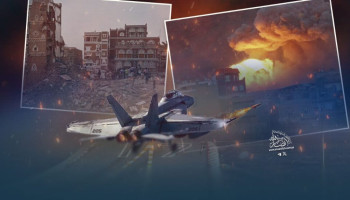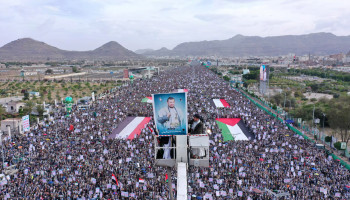The "Al-Aqsa Storm" battle on October 7, 2023, marked a significant turning point in the history of the region. Its events and subsequent developments laid the foundation for a new, unprecedented phase in the conflict with the temporary Israeli entity.
In past decades, Palestinian fighters relied on stones as their only means to stop the crimes and arrogance of the enemy. When Israeli soldiers oppressed and brutalized the Palestinian people, Arab television channels would rush to broadcast sorrowful songs, reflecting the helplessness of the Palestinian reality. In the worst cases, the Arab League would convene a summit, where leaders and dignitaries issued weak statements of condemnation.
However, the situation changed entirely after the Al-Aqsa Storm. Arab leaders moved beyond silence and denunciation to supporting the occupying entity, while their people remained distracted by entertainment and frivolous activities.
The Arab abandonment of the Palestinian cause resonated deeply with the resistance factions in Gaza. Days after the Al-Aqsa Storm and the horrific Zionist massacres, Hamas military spokesman Abu Obaida expressed disillusionment with the Arab regimes in his famous statement: "God forbid," signaling a deep despair over any potential Arab support for Palestine and Gaza in this unprecedented crisis.
In this reality, Yemen, under the leadership of Sayyed Abdulmalik al-Houthi, made a surprising stance. On October 11, 2023, he delivered a speech outlining Yemen's position on the conflict, stressing that the Islamic and Arab nations have a religious, humanitarian, and national duty to support the Palestinian people, both politically, materially, and even militarily.
Sayyed Abdulmalik wished that Yemen was geographically closer to Palestine, so its people could send hundreds of thousands of fighters to join the Palestinian struggle. Despite geographical constraints, he emphasized Yemen's readiness to act in any possible way, famously declaring: "You are not alone; the Yemeni people are with you."
The geographical distance between Yemen and occupied Palestine was clear, but his statement about doing everything possible raised questions, especially when he continued by saying that if the U.S. intervened militarily, Yemen was prepared to respond, even with missile and drone strikes.
Just weeks later, after much ridicule from adversaries about how Yemen could help Gaza amidst its own nine-year war, Yemeni missiles reached the occupied city of "Umm Rashrash," followed by drones. On October 31, Brigadier General Yahya Saree officially announced Yemen's entry into the battle, confirming al-Houthi's commitment to aiding the oppressed in Gaza and overcoming geographical barriers to reach the depths of the Israeli entity.
The Yemeni Armed Forces succeeded in blocking Israeli ships from passing through the Red Sea. Israel underestimated the move, but Yemen dealt a blow by capturing the Israeli-affiliated Galaxy ship on November 9, 2023. This action resonated globally, proving Yemen's seriousness in supporting Gaza.
In a further escalation, Yemen declared that any ship heading to Israeli ports in occupied Palestine, regardless of its nationality, would be a legitimate target if food and medicine were not allowed into Gaza.
Faced with these developments, the U.S. sought to form an international naval coalition to counter Yemen’s blockade. On December 19, 2023, the U.S. Department of Defense announced a ten-nation coalition, including America, the UK, France, and others. This coalition aimed to lift Yemen’s naval blockade, and on January 12, 2024, the first airstrikes began, targeting Yemeni provinces in an attempt to halt Yemen's operations in the Red Sea.
Despite these ongoing airstrikes, the spokesperson for the Yemeni Armed Forces, Brigadier General Yahya Saree, announced from the heart of Al-Sabeen Square the beginning of the fourth phase of escalation on May 3, 2024. A notable aspect of this announcement was the targeting of all ships violating the Israeli navigation ban and heading to the ports of occupied Palestine in the Mediterranean Sea, in any area within their reach.
The statement added that if the Israeli enemy launches a military aggression on Rafah, the Yemeni Armed Forces would impose comprehensive sanctions on all ships belonging to companies involved in supplying and entering the ports of occupied Palestine, regardless of their nationality, and prevent them from passing through the operational areas of the armed forces, regardless of their destination.
The expansion of Yemeni operations to the Mediterranean Sea surprised many, especially since it came after the success of the Yemeni forces in controlling operations in the Red and Arabian Seas, reaching the Indian Ocean. The move to the Mediterranean Sea tightened the blockade on the Israelis, leading to the bankruptcy of the port of "Umm al-Rashrash."
Among the major military operations during this phase were:
- The targeting of the American destroyer *Mason* in the Red Sea.
- Six military operations targeting six ships in the Mediterranean Sea, the Red Sea, and the Arabian Sea with cruise missiles.
- Targeting the American aircraft carrier *Eisenhower* in the Red Sea with cruise missiles, resulting in damage.
- Targeting the British destroyer *Diamond* in the Red Sea.
- Hitting the ship *Tutor* in the Red Sea, sinking it.
The fourth phase of escalation saw attacks on ships belonging to the "Axis of Evil" — the U.S., Britain, and Israel — with some being sunk and others heavily damaged. The blockade on Israel was tightened, leading to the complete bankruptcy of the port of "Umm al-Rashrash" in southern occupied Palestine.
Despite the intensity of these specialized operations during the fourth phase of escalation, the U.S. and Israeli enemies continued their aggressive actions in Gaza, intensifying attacks on civilians and tightening the siege, prompting the Yemeni Armed Forces to move into a new phase of escalation, titled the "fifth phase of escalation."
The first operation in this phase was the targeting of the occupied city of Jaffa, which the Israeli enemy calls "Tel Aviv," with a new drone named "Yafa" on July 19, 2024. This operation carried significant messages and dealt a painful blow to Israel, garnering worldwide attention.
The operation, which resulted in casualties among Israelis, succeeded in breaching Israel's multi-layered air defense systems, as well as American and Arab defenses. On that day, Sana'a declared that the occupied city of Jaffa was no longer safe.
The pace of events in the region intensified after this operation, with Israel carrying out a series of criminal actions, most notably the assassination of Hezbollah commander Fouad Shukr via a strike on southern Beirut and the assassination of the head of Hamas' political bureau, Ismail Haniyeh.
They also launched treacherous airstrikes on the port of Hodeidah, prompting the resistance axis to threaten retaliation against the Israeli enemy. However, due to certain circumstances, the axis opted for individual responses.
Hezbollah managed to strike an Israeli intelligence unit in the suburbs of "Tel Aviv" in response to the assassination of Commander Shukr, while the Yemeni Armed Forces targeted "Tel Aviv" with the hypersonic Palestine-2 missile for the first time. This was done without specifying whether it was retaliation for the Hodeidah incident, while Iran postponed its response for a later time.
To this day, the Yemeni Armed Forces still hold many surprises in their confrontation with Israel as part of the fifth phase of escalation. Their main objective is to "end the Israeli aggression and blockade on the Gaza Strip," with the assurance that the next phase will include more surprises if this goal is not achieved.
During both the fourth and fifth phases of Yemen's escalation against Israel, the Yemeni Armed Forces revealed a series of strategic weapons, including (Palestine-1 missile, Tufan boat, Hatim ballistic missile, Palestine-2 hypersonic missile, Quds-5 cruise missile, and Zulfiqar), in addition to the Yafa drone and Sammad-4.
The Yemeni Armed Forces also successfully targeted several ships belonging to the "Axis of Evil" — the U.S., Britain, and Israel — in the Red Sea, sinking some, such as the *Sonion* vessel.
The Yemeni air defenses also achieved significant success during the "Al-Aqsa Storm" operation, shooting down 11 MQ-9 drones, a pride of American unmanned aerial vehicles. These operations demonstrated the American failure to spy on Yemen and shattered the prestige of this type of weapon, prompting countries like India to cancel their purchase contracts.
One of the most notable outcomes of the fourth and fifth phases of escalation was the withdrawal of the U.S. aircraft carrier *Eisenhower* from the Red Sea, followed by the *Roosevelt* carrier and the British destroyer *Diamond*. The European coalition "Aspides" also failed to protect Israeli maritime traffic, in addition to the continued closure of the "Umm al-Rashrash" port. Most importantly, "Tel Aviv" has become an unsafe city.







